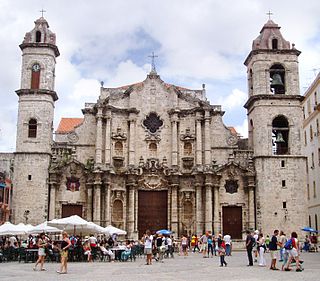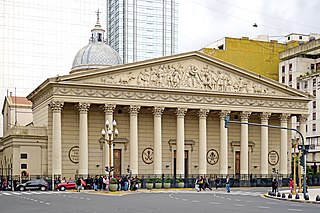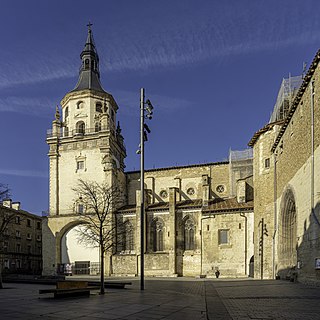
The Cathedral of the Holy Cross and Saint Eulalia, also known as Barcelona Cathedral, is the seat of the Archbishop of Barcelona in Catalonia, Spain. The cathedral was constructed from the thirteenth to fifteenth centuries, with the principal work done in the fourteenth century. The cloister, which encloses the Well of the Geese (Font de les Oques), was completed in 1448. In the late nineteenth century, the neo-Gothic façade was constructed over the nondescript exterior that was common to Catalan churches.

Trujillo is a municipality located in Extremadura, an autonomous community of Spain in the Province of Cáceres. In 2013 the municipality had 9,086 inhabitants. Originally settled on a granite knoll, which was readily fortified, the town now extends to the southeast of its original site. Trujillo is both a centre for tourism, with more than 25 hotels, and a regional market town.

Havana Cathedral is one of eleven Catholic cathedrals on the island. It is located in the Plaza de la Catedral on Calle Empedrado, between San Ignacio y Mercaderes, Old Havana, Havana, Cuba. The thirty by forty-nine meters rectangular church serves as the seat of the Archdiocese of San Cristóbal de la Habana. Christopher Columbus’s remains were kept in the cathedral between 1796 and 1898 before they were taken to Seville Cathedral.

The Buenos Aires Metropolitan Cathedral, officially called Buenos Aires Metropolitan Cathedral of the Holy Trinity, is the main Catholic church in Buenos Aires, Argentina.

Coria is a municipality of Spain belonging to the province of Cáceres, Extremadura. In addition to the town of the same name, the municipality also comprises the settlements of Puebla de Argeme and Rincón del Obispo. With a population of has 12,531 inhabitants, Coria is the fourth most-populated municipality in the province.

Pamplona Cathedral(Santa María de la Asunción) is a Roman Catholic church in the archdiocese of Pamplona, Spain. The current 15th century Gothic church replaced an older Romanesque one. Archaeological excavations have revealed the existence of another two earlier churches. The Neoclassical façade was designed by Ventura Rodríguez in 1783. It has a 13th-14th-century Gothic cloister that provides access to two other Gothic rooms: the Barbazan chapel and the refectory. The Mediaeval kings of Navarre were crowned and some also buried there. The Navarrese Cortes (Parliament) was held there during the early modern ages.

The Cathedral of the Holy Cross over the Waters is a Catholic cathedral in Cádiz, southern Spain, and the seat of the Diocese of Cadiz y Ceuta. It was built between 1722 and 1838. The cathedral was declared Bien de Interés Cultural in 1931.

The Cathedral of St Mary of the Assumption is a Roman Catholic church located in the Spanish city of Ceuta, in a small exclave on the northwest coast of Africa.

The Cathedral of San Cristóbal de La Laguna or Catedral de Nuestra Señora de los Remedios is a Roman Catholic church in Tenerife, Spain. Begun in 1904 and completed in 1915, it is dedicated to the Virgin of Los Remedios. The cathedral is the mother church of the diocese, which includes the islands of Tenerife, La Palma, La Gomera and El Hierro in the province of Santa Cruz de Tenerife. It is therefore where the episcopal seat of the bishop of this diocese, currently occupied by Bishop Bernardo Álvarez Afonso. This is one of the most important churches of the Canary Islands.

Teruel Cathedral or Catedral de Santa María de Mediavilla de Teruel is a Roman Catholic church in Teruel, Aragon, Spain. Dedicated to St. Mary, it is a notable example of Mudéjar architecture. Together with other churches in the town and in the province of Zaragoza, it has been listed as a UNESCO World Heritage Site since 1986.

The Metropolitan Cathedral of Saint John the Baptist is a Catholic cathedral in Badajoz, Extremadura, western Spain. Since 1994, together with the Co-cathedral of Saint Mary Major of Mérida, it is the seat of the Archdiocese of Mérida-Badajoz.

The Magistral Cathedral of Saint Justus and Saint Pastor is a Roman Catholic cathedral located in Alcalá de Henares, Spain. Together with Saint Peter's of Leuven, they are the only churches worldwide to hold the title of Magistral, as their canons are required to be doctors in Theology.

Getafe Cathedral is a Roman Catholic church located in Getafe, Spain. The edifice was a church for most of its existence, before becoming a cathedral in 1991 with the establishment of the Diocese of Getafe.

The Cathedral of Santa María de Vitoria is a Gothic-style, Roman Catholic cathedral located in Vitoria-Gasteiz, Basque country, Spain. It was declared Bien de Interés Cultural in 1931 and a World Heritage Site in 2015.

The Catedral of Saint Mary of Tortosa is a cathedral located in Tortosa, Catalonia, Spain and seat of the Diocese of Tortosa. The present structure is located in the center of the city's old town.

The Ourense Cathedral is a Roman Catholic church located in Ourense in Galicia. Dedicated to St Martin, it was founded in 550. The first structure was restored by Alonso el Casto. The present mainly Gothic building was raised with the support of Bishop Lorenzo in 1220. Its local patroness is Saint Euphemia. There is a silver-plated shrine, and others of St Facundus and St Primitivus. The Christ's Chapel was added in 1567 by Bishop San Francisco Triccio. It contains an image of Christ, which was brought in 1330 from a small church on Cape Finisterre. John the Baptist's Chapel was created in 1468 by the Conde de Benavente. The Portal of Paradise is sculptured and enriched with figures of angels and saints, while the antique cloisters were erected in 1204 by Bishop Ederonio. The Capilla de la Maria Madre was restored in 1722, and connected by the cloisters with the cathedral. The eight canons were called Cardenales, as at the Cathedral of Santiago de Compostela, and they alone did services before the altar; this custom was recognised as "immemorial" by Pope Innocent III, in 1209. The cathedral, which has undergone an impressive transition of architectural styles of Romanesque, Gothic, Renaissance, Baroque and Neoclassical, was built to a Latin Cross plan. It has been a functional basilica since 1887. The cathedral has a crucifix that is held in great reverence all over Galicia.

New Cathedral of Plasencia or Catedral de Asunción de Nuestra Señora is a Roman Catholic cathedral located in the town of Plasencia, Region of Extremadura, Spain. It is dedicated to the Virgin Mary.

The Old Cathedral of Plasencia is a Roman Catholic church in Plasencia, Cáceres Province, Extremadura, Spain. It is one of two cathedrals in Plasencia, the other being the New Cathedral.




















